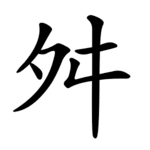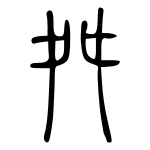Radical 136
Radical 136 meaning "oppose" is 1 of 29 Kangxi radicals (214 radicals total) composed of 6 strokes.
| 舛 | ||
|---|---|---|
| ||
| 舛 (U+821B) "oppose" | ||
| Pinyin: | chuǎn | |
| Bopomofo: | ㄔㄨㄢˇ | |
| Wade–Giles: | ch'uan3 | |
| Cantonese Yale: | chyun2 | |
| Jyutping: | cyun2 | |
| Kana: | セン sen そむく somuku | |
| Kanji: | 升 masu | |
| Hangul: | 어그러질 eogeureojil | |
| Sino-Korean: | 천 cheon | |
| Stroke order animation | ||
 | ||
In the Kangxi Dictionary there are 10 characters (out of 49,030) to be found under this radical.
Characters with Radical 136

seal script character
| strokes | character |
|---|---|
| without additional strokes | 舛 |
| 6 additional strokes | 舜 |
| 7 additional strokes | 舝 |
| 8 additional strokes | 舞 |
Literature
- Fazzioli, Edoardo (1987). Chinese calligraphy : from pictograph to ideogram : the history of 214 essential Chinese/Japanese characters. calligraphy by Rebecca Hon Ko. New York: Abbeville Press. ISBN 0-89659-774-1.
- Lunde, Ken (Jan 5, 2009). "Appendix J: Japanese Character Sets" (PDF). CJKV Information Processing: Chinese, Japanese, Korean & Vietnamese Computing (Second ed.). Sebastopol, Calif.: O'Reilly Media. ISBN 978-0-596-51447-1.
gollark: Just take a random one from https://i.osmarks.tk, he seems to like some of those.
gollark: Why.
gollark: Guess they're Ale!
gollark: "Ale"? Interesting.
gollark: Theory: all Krist addresses are now controlled by Terrariola.
This article is issued from Wikipedia. The text is licensed under Creative Commons - Attribution - Sharealike. Additional terms may apply for the media files.